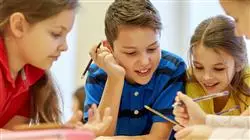University certificate
The world's largest faculty of psychology”
Introduction to the Program
With this 100% online Master’s Degree, you will ffficiently prepare to design educational interventions based on brain function and neuroscientific evidence”

Neuropsychology has gained increasing relevance in the educational field, particularly within Psychology, as it enables a profound understanding of the brain processes underlying learning, behavior, and cognitive development. This specialization is essential for identifying, analyzing, and addressing learning difficulties from a scientific perspective, integrating knowledge of the nervous system, brain function, and their impact on academic and socioemotional skills.
In response to this need, TECH Global University has developed this comprehensive Masters Degree in Neuropsychology and Education. Throughout the academic program, students will explore topics such as child neuropsychological assessment, neurodevelopmental disorders, memory, learning styles, and intervention strategies adapted to different educational contexts. The program will also provide an in-depth examination of the role of executive functions, attention, language, and emotional self-regulation—essential components for a comprehensive approach.
Graduates of this university qualification will acquire a highly sought-after professional profile for employment in psycho-pedagogical teams, clinical practices, educational centers, and institutions dedicated to guidance and psychopedagogical evaluation. Moreover, the ability to apply diagnostic tools and design personalized intervention plans will enable graduates to lead processes aimed at improving academic performance and promoting educational inclusion, thereby significantly enhancing their employability and professional competitiveness.
This postgraduate program is delivered in a fully online format, offering complete flexibility to organize training without interrupting professional or personal commitments. In addition, TECH exclusive Relearning methodology will optimize learning through the intelligent repetition of key concepts, facilitating deep and lasting knowledge assimilation. Thanks to this innovative pedagogical approach, professionals will advance efficiently and autonomously, accessing all learning materials at any time and from any internet-connected device.
You will drive educational transformation with scientific tools that place the brain at the center of the teaching process. Take the step to elevate your knowledge to a new level!”
This Masters Degree in Neuropsychology and Education contains the most complete and up-to-date university program on the market. Its most notable features are:
- The development of practical cases presented by experts in Neuropsychology and Education
- The graphic, schematic, and practical contents with which they are created, provide scientific and practical information on the disciplines that are essential for professional practice
- Practical exercises where self-assessment can be used to improve learning
- Special emphasis on innovative methodologies in Neuropsychology and Education
- Theoretical lessons, questions to the expert, debate forums on controversial topics, and individual reflection assignments
- Content that is accessible from any fixed or portable device with an internet connection
You will identify early various cognitive alterations that affect academic performance from a neuropsychological perspective”
The faculty includes professionals from the fields of neuropsychology and education, who contribute their practical experience to this program, along with renowned specialists from leading societies and prestigious universities.
The multimedia content, developed with the latest educational technology, will provide the professional with situated and contextual learning, i.e., a simulated environment that will provide an immersive learning experience designed to prepare for real-life situations.
This program is designed around Problem-Based Learning, whereby the student must try to solve the different professional practice situations that arise throughout the program. For this purpose, the professional will be assisted by an innovative interactive video system created by renowned and experienced experts.
You will master the use of neuropsychological measurement instruments applied to memory, attention, and executive functions"

A curriculum based on the disruptive Relearning system will facilitate the assimilation of complex concepts in a fast and flexible way"
Why study at TECH?
TECH is the world’s largest online university. With an impressive catalog of more than 14,000 university programs available in 11 languages, it is positioned as a leader in employability, with a 99% job placement rate. In addition, it relies on an enormous faculty of more than 6,000 professors of the highest international renown.

Study at the world's largest online university and guarantee your professional success. The future starts at TECH”
The world’s best online university according to FORBES
The prestigious Forbes magazine, specialized in business and finance, has highlighted TECH as “the world's best online university” This is what they have recently stated in an article in their digital edition in which they echo the success story of this institution, “thanks to the academic offer it provides, the selection of its teaching staff, and an innovative learning method aimed at educating the professionals of the future”
A revolutionary study method, a cutting-edge faculty and a practical focus: the key to TECH's success.
The most complete study plans on the university scene
TECH offers the most complete study plans on the university scene, with syllabuses that cover fundamental concepts and, at the same time, the main scientific advances in their specific scientific areas. In addition, these programs are continuously being updated to guarantee students the academic vanguard and the most in-demand professional skills. In this way, the university's qualifications provide its graduates with a significant advantage to propel their careers to success.
TECH offers the most comprehensive and intensive study plans on the current university scene.
A world-class teaching staff
TECH's teaching staff is made up of more than 6,000 professors with the highest international recognition. Professors, researchers and top executives of multinational companies, including Isaiah Covington, performance coach of the Boston Celtics; Magda Romanska, principal investigator at Harvard MetaLAB; Ignacio Wistumba, chairman of the department of translational molecular pathology at MD Anderson Cancer Center; and D.W. Pine, creative director of TIME magazine, among others.
Internationally renowned experts, specialized in different branches of Health, Technology, Communication and Business, form part of the TECH faculty.
A unique learning method
TECH is the first university to use Relearning in all its programs. It is the best online learning methodology, accredited with international teaching quality certifications, provided by prestigious educational agencies. In addition, this disruptive educational model is complemented with the “Case Method”, thereby setting up a unique online teaching strategy. Innovative teaching resources are also implemented, including detailed videos, infographics and interactive summaries.
TECH combines Relearning and the Case Method in all its university programs to guarantee excellent theoretical and practical learning, studying whenever and wherever you want.
The world's largest online university
TECH is the world’s largest online university. We are the largest educational institution, with the best and widest online educational catalog, one hundred percent online and covering the vast majority of areas of knowledge. We offer a large selection of our own degrees and accredited online undergraduate and postgraduate degrees. In total, more than 14,000 university degrees, in eleven different languages, make us the largest educational largest in the world.
TECH has the world's most extensive catalog of academic and official programs, available in more than 11 languages.
Google Premier Partner
The American technology giant has awarded TECH the Google Google Premier Partner badge. This award, which is only available to 3% of the world's companies, highlights the efficient, flexible and tailored experience that this university provides to students. The recognition as a Google Premier Partner not only accredits the maximum rigor, performance and investment in TECH's digital infrastructures, but also places this university as one of the world's leading technology companies.
Google has positioned TECH in the top 3% of the world's most important technology companies by awarding it its Google Premier Partner badge.
The official online university of the NBA
TECH is the official online university of the NBA. Thanks to our agreement with the biggest league in basketball, we offer our students exclusive university programs, as well as a wide variety of educational resources focused on the business of the league and other areas of the sports industry. Each program is made up of a uniquely designed syllabus and features exceptional guest hosts: professionals with a distinguished sports background who will offer their expertise on the most relevant topics.
TECH has been selected by the NBA, the world's top basketball league, as its official online university.
The top-rated university by its students
Students have positioned TECH as the world's top-rated university on the main review websites, with a highest rating of 4.9 out of 5, obtained from more than 1,000 reviews. These results consolidate TECH as the benchmark university institution at an international level, reflecting the excellence and positive impact of its educational model.” reflecting the excellence and positive impact of its educational model.”
TECH is the world’s top-rated university by its students.
Leaders in employability
TECH has managed to become the leading university in employability. 99% of its students obtain jobs in the academic field they have studied, within one year of completing any of the university's programs. A similar number achieve immediate career enhancement. All this thanks to a study methodology that bases its effectiveness on the acquisition of practical skills, which are absolutely necessary for professional development.
99% of TECH graduates find a job within a year of completing their studies.
Master's Degree in Neuropsychology and Education
Neurosciences have long been linked to psychological practice due to their exploration of human behavior from innovative perspectives. Whether elucidating the congenital basis of various mental and psychomotor disorders or developing new theoretical and practical models that facilitate learning, the study of the brain proves to be of great value in the field of the psyche. Seeking to make the most of these approaches, TECH Global University has designed the Master’s Degree in Neuropsychology and Education—an optimal complement for all professionals wishing to provide a new direction to psychotherapeutic paradigms, thereby improving the educational processes of children and adolescents. Thanks to our fully online format, you will be able to acquire unique skills in psychosocial intervention through self-paced classes, accessible according to your own schedule and from any internet-connected device. The extensive multimedia content, based on clinical case analysis, together with the Relearning methodology—leading the contemporary higher education market—will help you transform the vision of new generations and achieve outstanding professional growth.
Earn your degree online as a neuropsychologist and educator
Both the perception of the world and the emotional states resulting from such interactions originate in a single process: synapsis. This communication between nerve cells is what enables you to read this text. Each synaptic impulse contains approximately 4.7 bits of information. When these data are compared with the total number of available neurons, it means that the brain can store up to one trillion bits—almost all the content that exists on the internet. Neuropsychology allows for a deeper exploration of brain structures in search of methods to harness this potential in fields such as learning. This is precisely the focus of our master’s program. This virtual journey comprises nine thematic modules through which you will learn not only the foundations of neuroscience, but also other fascinating areas such as multiple intelligences, motor and lateral development, linguistic processes, hyperactivity, and, of course, neuroeducation. Would you like to take your vocation to the next level? Enroll with us and achieve it successfully.







